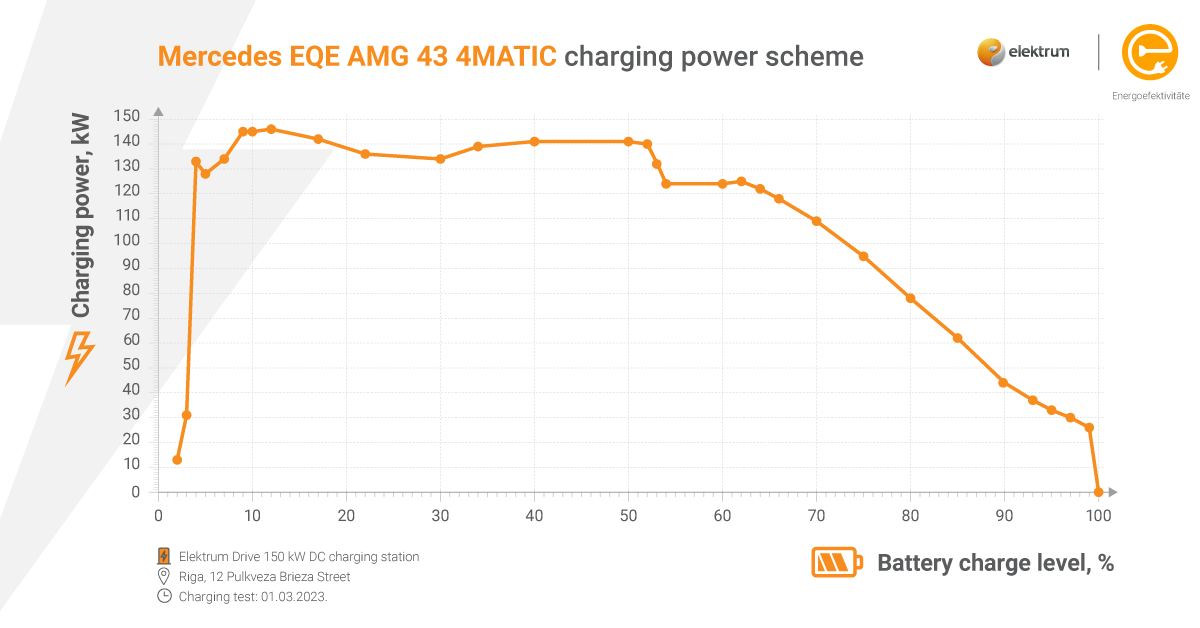Mercedes EQE AMG 43 4MATIC
Battery capacity: 100.0 kWh
Battery capacity usable: 90.6 kWh
| Range, km | Efficiency, kWh/100km | AC Charging, km/h | DC Charging, km/h | |
|---|---|---|---|---|
| Official | 463 | 20 | 50 | 720 |
| Elektrum | 370 | 23 | 50 | 635 |
Battery capacity: 100.0kWh
Battery capacity: 100.0 kWh
Battery capacity usable: 90.6 kWh
| Range, km | Efficiency, kWh/100km | AC Charging, km/h | DC Charging, km/h | |
|---|---|---|---|---|
| Official | 463 | 20 | 50 | 720 |
| Elektrum | 370 | 23 | 50 | 635 |

| Car Body | Sedan | Acceleration 0-100 km/h | 4.2 sec |
| Seats | 5 | Top Speed | 210 km/h |
| Length | 4946 mm | Total Power | 350 kW (476 PS) |
| Width | 1906 mm | Total Torque | 858 Nm |
| Width with mirrors | 2104 mm | Weight Unladen (EU) | 2525 kg |
| Height | 1492 mm | Gross Vehicle Weight (GVWR) | 3095 kg |
| Tow Hitch | Yes | Cargo Volume | 430 L |
| Roof Rails | No | Cargo Volume Max | 895 L |

The maximum mileage depending on the season and mode is between 355 - 685 km
| Route | EV-database data | Elektrum summer test | Elektrum winter test |
|---|---|---|---|
| City | 465 - 685 | - | - |
| Highway | 355 - 460 | - | - |
| Combined | 410 - 555 | - | 370 |
The table shows the maximum mileage recorded by Elektrum experts during the test run in ECO mode and using A/C in the summer season and heating in the winter season. Actual maximum mileage depends on the driving speed, route, driving style, climatic and other conditions.

Energy consumption depending on the season and mode is between 13.2 - 25.5 kWh/100km
| Route | EV-database data | Elektrum summer test | Elektrum winter test |
|---|---|---|---|
| City | 13.2 - 19.5 | - | 20.8 |
| Highway | 19.7 - 25.5 | - | 24.5 |
| Combined | 16.3 - 22.1 | - | 20.0 |
| Speed, km/h | Elektrum summer test, kWh/100km | Elektrum winter test, kWh/100km |
|---|---|---|
| 50 | - | 17.1 |
| 70 | - | 20.7 |
| 90 | - | 23.9 |
The table shows the energy consumption recorded on the electric vehicle's on-board computer during the test drive by Elektrum experts when driving in ECO mode and using A/C in the summer season and heating in the winter season. Actual energy consumption depends on the driving speed, route, driving style, climatic and other conditions.

Total battery capacity
Usable battery capacity
| Battery Type |
Lithium-ion |
Architecture | 400 V |
| Number of Cells | 360 | Bidirectional Charging (V2L) | Not Available |
| Nominal Voltage | 328 V | Bidirectional Charging (V2H) | Not Available |
| Pack Configuration | 90s4p | Bidirectional Charging (V2G) | Not Available |
| Max. AC Charge Power | 11 kW | Max. DC Charge Power | 173 kW |
| Charging type | Charge Port | Port Location | Max. Power | Time | Rate |
|---|---|---|---|---|---|
|
Wall Plug |
Type 2 | Right Side - Rear | 2.3 kW | 46 hours 30 minutes | 10 km/h |
|
1-phase 16A |
3.7 kW | 29 hours | 17 km/h | ||
|
1-phase 32A |
7.4 kW | 14 hours 30 minutes | 33 km/h | ||
|
3-phase 16A |
11 kW* |
9 hours 45 minutes |
50 km/h | ||
|
3-phase 32A |
22 kW** | 9 hours 45 minutes | 50 km/h |
* Elektrum experts recommend: the most suitable home charger for this car from Elektrumveikals.lv: ABB Terra, 11 kW
** Limited by on-board charger, vehicle cannot charge faster.
| Charging Point | Charge Port | Port Location | Max. Power | Avg. Power | Charge Time | Charge Speed |
| 50 kW DC | CCS | Right Side - Rear | 46 kW | 44 kW | 1 hours 31 minutes | 220 km/h |
| 150kW DC | 150 kW | 133 kW | 30 minutes | 670 km/h | ||
| 300kW DC | 173 kW | 142 kW | 28 minutes | 720 km/h |
| Parameters | 150kW DC charging |
|---|---|
| Average charging speed up to 80% | 634 km/h |
| Average charging power (5%-80%) | 118 kW |
| Time to charge for 100 km | 9 minutes |
| Charging time (5->50%) | 19 minutes |
| Charging time (5->70%) | 29 minutes |
| Charging time (5->80%) | 35 minutes |
| Charging time (5->90%) | 45 minutes |
| Charging time (5->95%) | 52 minutes |
Actual charging data depends on the capacity available at the station and the specifications of the electric vehicle’s built-in battery - mainly the capacity and temperature during charging.




The WLTP (Worldwide Harmonised Light Vehicles Test Procedure) standard data for the specific model of the electric vehicle is used in the comparison calculation. The WLTP standard is based on worldwide driving data and includes driving situations in both urban and highway traffic. Actual maximum mileage, average consumption and acceleration depend on the specific model of electric vehicle and its equipment, chosen route, driving style, climatic and other conditions.